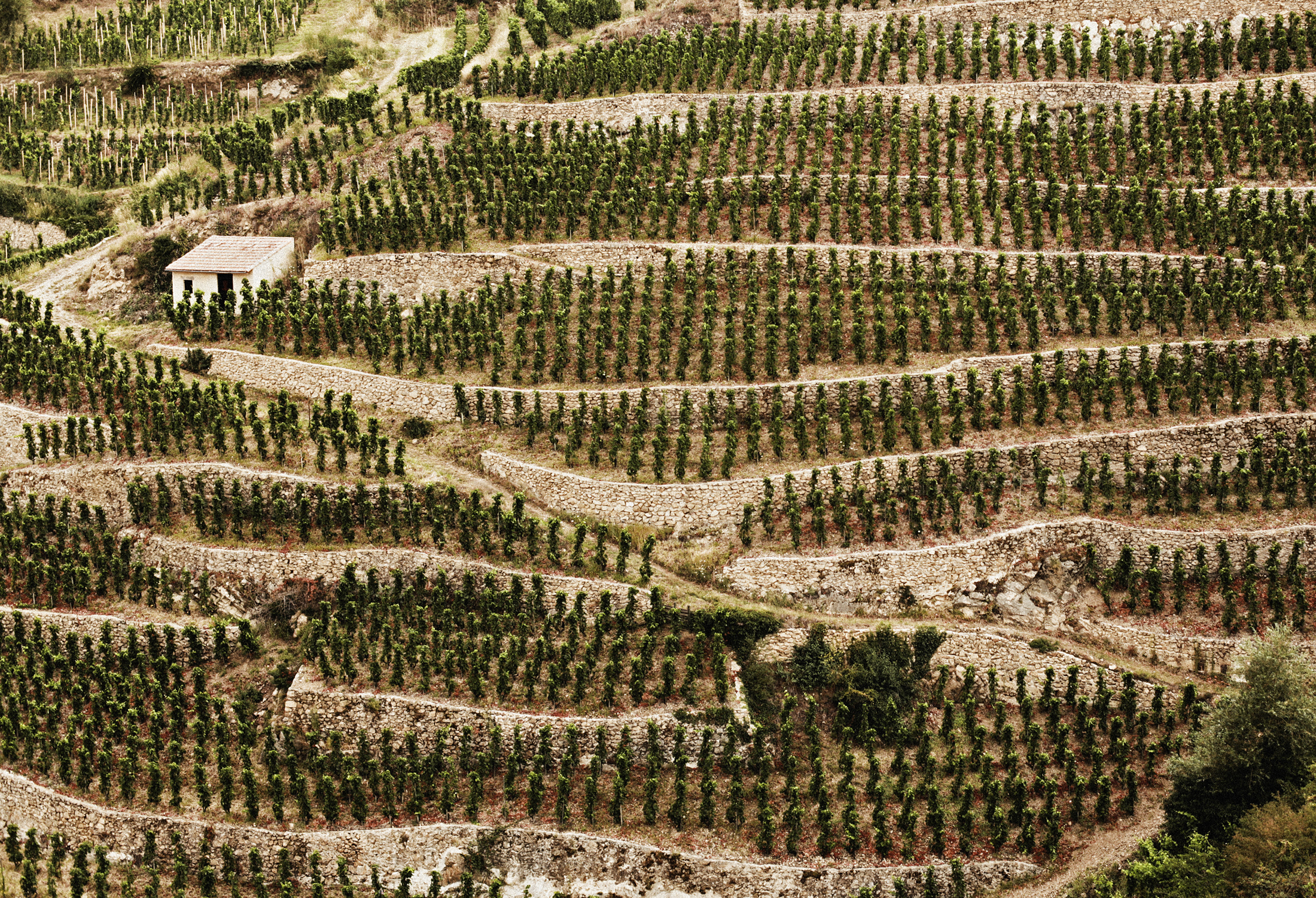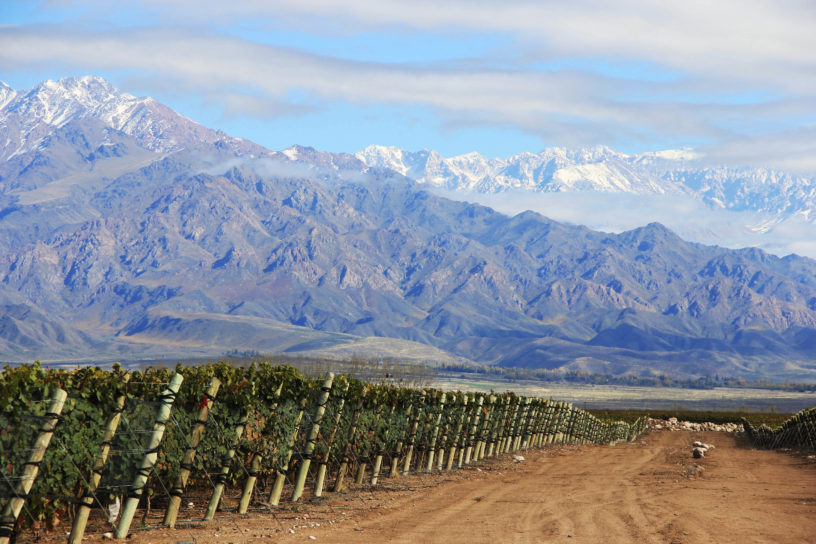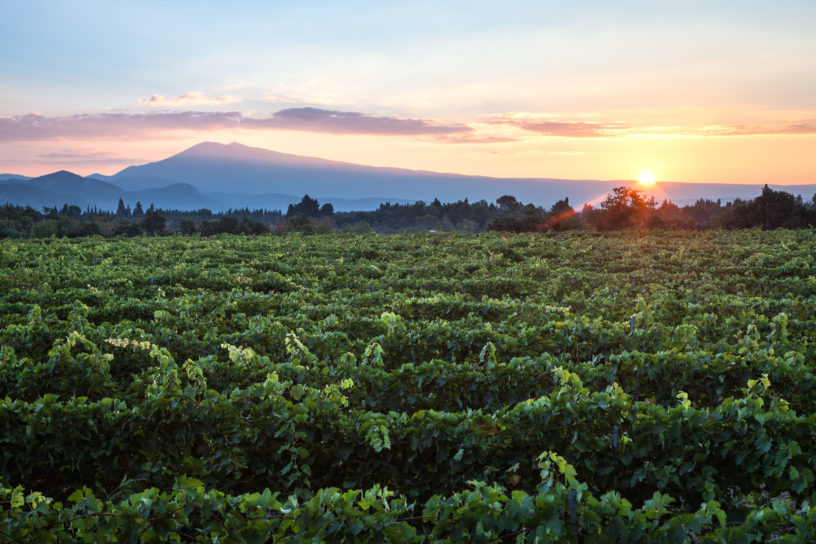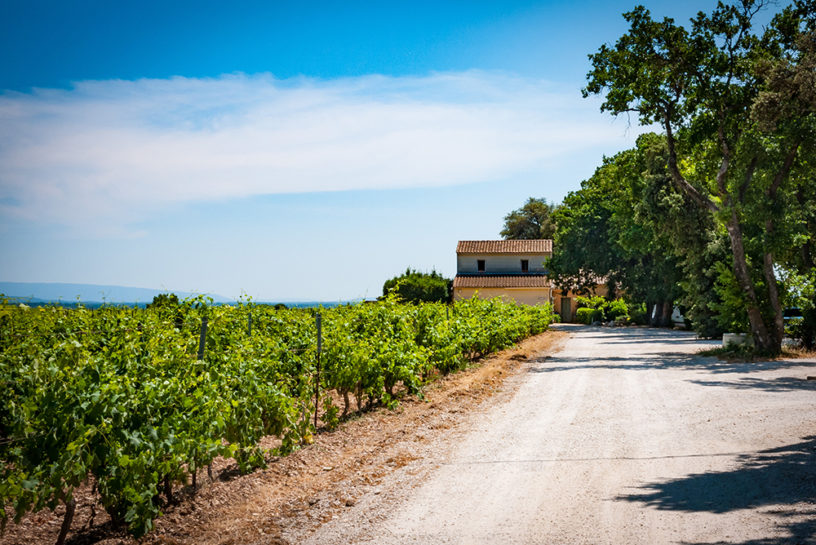The Great Terroir Debate
Wine on the rocks.

The word terroir slips off the tongues of winemakers and wine marketers with the silky ease their wines often make during the reverse journey. “We have a special terroir that our wines reflect,” a winemaker declares. “Our wines are terroir driven,” asserts a marketer. The essence of it is that terroir—the physical environment that grapevines grow in, especially the climate and soil—imprints itself on the grapes and therefore on the wines they make. Thus the similar claim that some wines “have a sense of place,” meaning they reflect or express the place where the grapes grew.
In the last few decades, special importance has been given to the soils and rocks that grapevines grow in, and many wine professionals argue that certain kinds of rocks give wines particular qualities. For example, some say that limestone and granite in vineyards give wines “minerality” and that vineyards with slate (like those in Germany’s Mosel Valley) produce wines with a “slate-y” flavour or texture.
The idea of terroir (from the Latin word for territory) has existed in France since the Middle Ages. At first it was mainly associated with people, languages, and the arts. In the 1500s, the French essayist Michel de Montaigne wrote that “The very form of our being—not only our colour, build, complexion, and behaviour, but our mental faculties as well—depends upon our native air, climate, and terroir.” A century later, another writer noted that “Each language seems to be influenced by the nature of the terroir” where its speakers lived: the inhabitants of Provence had a “lively and amusing” way of speaking, while people from Normandy had “something of a rude drawl.”
The active agent was thought to be vapours that rose from the earth, and that people literally inhaled the character of the soils and rocks beneath them. Over time, terroir was increasingly attributed to plants that drove their roots into the ground, picked up qualities from the soil, and transmitted them to the foods and drinks they produced. And the belief arose that grapevines derived flavours and qualities from soil and rocks, and conveyed a “taste of the soil” (goût de terroir) to the resulting wines.

Bodega Zuccardi Valle de Uco
The modern idea of terroir (the total environment of a vineyard) covers more than rocks and soil, and it took shape in Burgundy as recently as the 1920s and ’30s. Sales of Burgundy’s wines were in the doldrums, and pointing to the uniqueness of the region’s physical and human landscape proved a successful way of highlighting the wines’ distinctiveness and quality. This version of terroir was a romantic concept in which wine emerged from the interplay of Burgundy’s climate, soil, history, and vignerons—people of modest means who cultivated small parcels of vines and made their own wine. Burgundy is thought to be the French region that most sensitively expresses terroir (compared, for instance, with Bordeaux and Champagne), and it is largely because Burgundy claimed terroir as its own unique property.
Sometime in the last few decades, within the concept of terroir, soils and rocks pushed climate, history, and winemakers almost entirely out of the picture. Perhaps it was because producers all over the world found limestone, granite, and other rocks underlay both their own vineyards and the prestigious vineyards of France. Finding a match in terms of climate was far more difficult and having a comparable history was impossible. So began the discourse in which soils and rocks became the definitive influences on wines.
Almost everyone seemed to believe this until some scientists ruined the party. One of the most prominent is Alex Maltman, a soil scientist and winemaker, who wrote a series of influential articles and a book, Vineyards, Rocks, & Soils: The Wine Lover’s Guide to Geology that debunked the idea that vines pick up materials from the soil that can be detected in the flavours or textures of wines. Maltman reports that it was Henri Coquand, a French geologist, who first suggested that bedrock geology influenced wine. That was in 1856 and, Maltman writes, “The whole proposal was part of a playful after-dinner speech, [and] it has been argued that he never intended the idea to be taken seriously. Little did he know.”

Montirius Le Domaine
Indeed. You have only to visit a few wineries to be told that the wine reflects the granite, the limestone, or the basalt that underlies the vines. Vineyards around the world are dotted with pits dug so that visitors can view the soil and rock strata. At Bodega Zuccardi Valle de Uco winery in Argentina’s Mendoza region, guests are invited to lick rocks to see that the texture of the rock is similar to the texture of the wine. At Montirius Le Domaine, in the southern Rhone valley, visitors are urged to chew vineyard dirt to understand the connection between the soil and the wine.
The soil structure of a vineyard is important, but more for its drainage properties than anything else, and certainly not because it passes on flavours and textures to the wine. As for aroma and flavour profiles, the fermentation process and the yeasts involved are far more influential. You might say that if a wine has a sense of place, that place is the winery, not the vineyard.
The obsession with vineyard rocks and their effects on wine has led to the popularity of wine descriptors such as “minerality” and “wet stone”. There is much debate about the meaning of minerality especially, and its supporters generally argue that it is a quality derived from minerals in the soil. But Maltman points out that the minerals present in wines in a nutritional sense exist in concentrations well below the level at which human beings can perceive them. As for minerals in the sense of rocks, vines take up nothing from them at all. For the same reason, the wet stone descriptor that is often used should not be thought of in literal terms, as stones have no more smell or flavour than glass.

Montirius Le Domaine
Some defenders of such terms argue that they should be thought of metaphorically, in the same way that fruit and spice descriptors (such as plum, citrus, and pepper) are used to describe wine aromas and flavours. No one thinks that plums, lemons, or pepper are added to wine, and no one need think that rocks or stones give flavours or textures to wine. The problem with this, says British wine writer Andrew Jefford, is that too many people can’t help making the connection between these terms and vineyard soil, and for that reason it is best to avoid them. “Scents and flavours are assigned mineral triggers,” Jefford writes, in the foreword of Maltman’s aforementioned book. “Tasteless minerals, indeed, [are said to] acquire aromas and flavours of their own … Geological terminology litters wine labels, sprinkles wine textbooks, and comes tumbling from the lips of sommeliers. Received truths about the necessary impacts of ‘limestone soils’ or ‘granite soils’ are unthinkingly recycled. Wine fairytales, if they come sprinkled with a little geological terminology, emerge with the foot-stomping force of a gospel truth choir.”
The debunking of the notion that rocks give flavour and texture to wine—and the accompanying undermining of the idea of terroir—has not gone unchallenged. Acclaimed British wine writer Jamie Goode declared that one scientific book’s referring to terroir as a myth was “an absurdity”. Prominent American wine writer Matt Kramer denounced the same book, Terroir and Other Myths of Winegrowing by Mark A. Matthews, (and “academic wine scientists” in general), arguing that anyone who tastes wines from different regions can detect the differences. The reasons for such differences, he wrote, “are collectively called terroir. What’s so hard to accept about that?”
As the opponents and proponents of terroir fight from their trenches—the walls of which clearly show the geological strata of their defensive positions—the mass of wine professionals carry on unperturbed. Winemakers stand in their vineyard pits to demonstrate the soils their vines grow in, and wine labels continue to specify the soils and subsoils of the vineyards. But the consensus on the meaning of terroir and the role of geology have been shattered. Terroir has had many meanings over time. The question is whether a new, broadly acceptable definition can be forged, or whether it is no longer a useful way of explaining and describing wine. 
_______
Never miss a story. Sign up for NUVO’s weekly newsletter, here.




